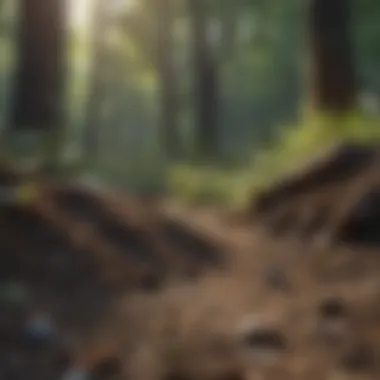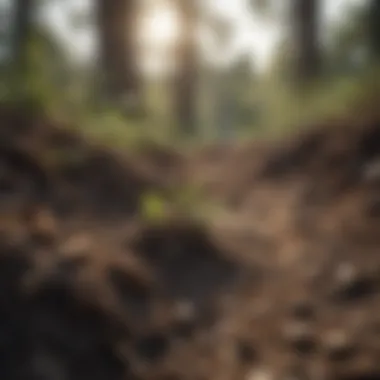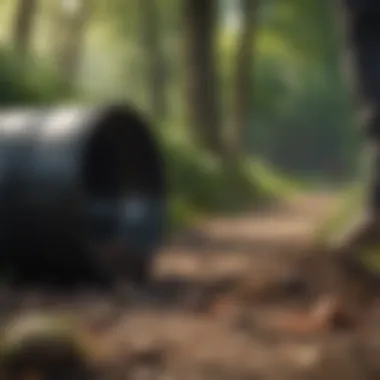Materials You Should Never Compost: A Complete Guide


Overview of the Topic
Composting, as a method of converting organic waste into a nutrient-rich soil amendment, has garnered significant attention among environmentalists and conservationists. The core idea hinges on turning waste into resources, a beautiful dance between nature and human intervention. However, it’s essential to know that not all organic materials are compatible with this process. Misguided composting efforts can lead to undesirable results and even harm the environment. This article aims to demystify the types of materials that shouldn’t find their way into your compost pile, presenting a comprehensive guide filled with insights.
Background Information
The art of composting has ancient roots, with various cultures integrating it into their agricultural practices. Yet, with the rise of modern conveniences, people have vacated their familiarity with what’s compostable and what leads to complications. Understanding the significance of not composting certain items is crucial. It ensures that the composting process thrives, enriching soil while avoiding contaminants that can pose detrimental effects to both ecosystems and human health. There’s nothing fancy about it; merely separating the beneficial from the harmful can lead to a healthier compsting outcome.
Current Status and Challenges
In many regions, composting is becoming a standard practice as society shifts toward eco-friendliness. Still, inappropriate materials are frequently added, causing challenges in the composting process. Common offenders include meats, fats, and greasy scraps, which can attract pests and create odors during decomposition. Not surprisingly, some brightly colored packaging often makes its way into compost bins, forgetting that digitized visuals do not equal natural materials. The challenge lies in public awareness; many people simply don’t realize that some items lead to negative consequences.
Sustainable Solutions
Education serves as the foundation of sustainable composting practices. Encouraging communities to engage in workshops about what belongs and what does not can foster a more informed population. Another effective solution is the creation of a composting guide, either physically distributed or made accessible online. To illustrate, let’s consider instances where local organizations successfully initiated community composting projects and saw waste reduction and improved soil quality.
Successful Case Studies
- In San Francisco, city-wide composting programs have not only diverted waste from landfills but also provided workshops that educated residents about composting intricacies.
- A local farmers' market in Portland collaborated with participants to create a poster indicating what should and shouldn't go into compost bins, significantly improving compost quality over time.
Impact and Importance
The importance of addressing what goes into compost extends beyond the local level; it builds a ripple effect impacting ecosystems and communities. Poor composting practices can lead to soil diseases and nutrient imbalance, affecting plant growth and, ultimately, food systems. Preserving healthy soils ensures that future generations can enjoy healthy ecosystems.
In summary, understanding the complexities of composting ensures we contribute positively to the environment. Curbing incorrect compostable materials doesn’t just foster healthy soil, but also aligns with broader sustainable initiatives, securing a fertile future for all.
While this article provides an initial dive into the do's and don'ts of composting, it sets the stage for a more detailed exploration of specific materials to avoid, giving readers the tools they need to make informed decisions.
Prelims to Composting
Composting stands out as a pivotal component in waste management and environmental health. It plays a significant role not only in reducing landfill waste but also in enhancing soil fertility and promoting sustainable gardening practices. Understanding composting is key—you’re not just tossing scraps into a bin. It involves a delicate interplay of materials, conditions, and microorganisms that can transform kitchen waste into rich, nutrient-filled compost. Knowing how to navigate this process is crucial for anyone committed to eco-friendly living.
Understanding Composting
At its core, composting refers to the natural process of decomposition, where organic matter breaks down into a dark, crumbly substance known as compost. This process comes with a rich cast of microorganisms, insects, and worms, all working together to break down the material. Think of it as nature’s way of recycling. For instance, apple cores from your kitchen don’t just end up wilting in a trash heap; they can instead turn into valuable food for your garden by enriching the soil.
However, to fully grasp composting, you need to recognize the variables at play. Moisture levels, aeration, temperature, and the carbon-to-nitrogen ratio are all elements that influence how effectively compost is made. Each layer of material added to the compost pile plays a role, requiring conscientious consideration to create an optimal environment for breakdown.
Benefits of Composting
The rewards of composting are multifaceted and far-reaching. First and foremost, it reduces the volume of waste sent to landfills—by as much as 30%. This reduction is vital in an era where land disposal is hitting capacity across a variety of regions.
Moreover, composting enhances soil health. Rich compost serves as a powerhouse for your garden, imbuing the earth with essential nutrients that promote plant growth. It improves soil structure, boosts water retention, and decreases the need for chemical fertilizers. This is especially important for those leaning towards organic gardening practices.
In addition to enhancing soil, composting acts as a carbon sink. The composting process can help mitigate climate change by sequestering carbon that would otherwise contribute to the greenhouse effect. Investing in composting is essentially investing in a cleaner environment.
- Not only does it add to the biodiversity of your garden, but it also encourages the presence of beneficial organisms crucial for a thriving ecosystem.
- It promotes waste reduction and fosters a deeper connection with the environment, as dedicating your time to composting highlights the value of your waste products.
"Composting transforms the old into the new, serving as a vital tool for sustainability and environmental responsibility."
The Importance of Knowing What Not to Compost
When embarking on the composting journey, understanding what materials should be left out of the compost pile is just as crucial as knowing what to include. Wrong choices can lead to a lot of headaches down the line, not to mention the potential harm to the environment. Identifying and avoiding certain items can minimize contamination, ensure a healthier composting process, and ultimately yield better soil quality.


Avoiding Contaminants
One of the primary reasons to be diligent about what goes into your compost is to prevent contaminants from sneaking in. Contaminants can come from various sources, often in unsuspected forms. For instance, food items like meats and dairy might seem harmless in your eyes, but they can attract pests and rodents, wreaking havoc in your backyard.
Moreover, items containing chemicals, such as certain types of treated wood or products laced with pesticides, can introduce toxins into your soil. The presence of these unwelcome materials not only complicates the composting process but also jeopardizes the safety of the resulting compost. If you’re not careful, you could end up nurturing plants with harmful chemicals, negating any good your compost could offer.
"The more we know about what not to compost, the clearer the path to producing rich, healthy soil becomes."
It’s easy to overlook small details when you’re eager to start composting. A steadfast approach to avoiding contaminants helps secure your compost's purity and promotes a thriving ecosystem of microorganisms. These beneficial little guys are crucial to breaking down organic materials and ensuring that what you get from your compost is nutrient-dense.
Maintaining Compost Quality
If you’re aiming for quality compost, knowing what not to toss in must be a top priority. Quality is often dictated by the interplay of various elements within the compost pile. When unsuitable materials are thrown into the mix, it can disrupt this delicate balance. For instance, an overload of plant materials that have been treated with pesticides can lead to poor-quality compost.
Furthermore, including items like fatty foods or oils can cause your compost to become smelly and greasy, which makes the decomposition process sluggish. It becomes a perfect storm of problems where the output you seek is sacrificed at the altar of convenience.
To ensure the end product is rich in nutrients, maintain a diverse mixture of composting ingredients. Aiming for the right carbon-to-nitrogen ratio is a good strategy. Including safe, organic materials like fruit scraps, veggies, and yard waste can promote a lovely, high-quality compost. The goal is to create a homely paradise for organisms that do the hard work of breaking things down.
Ultimately, being aware of what not to compost helps maintain the integrity and effectiveness of the composting process. It allows you to optimize your efforts and contribute positively to soil health and sustainability.
Categories of Materials to Avoid
Understanding which materials to steer clear of during composting is crucial for maintaining a healthy compost pile. Composting, while a natural way to enrich soil, can be easily derailed by the inclusion of certain items. This section delves into specific categories of materials that are best left out of your compost heap, aiming to prevent contamination and maintain the integrity of the composting process. It provides insights into why these materials are harmful and explores the potential benefits of alternative disposal methods.
Animal Products
Meat
Including meat in compost is a recipe for trouble. Meat can attract unwanted pests like rats and raccoons, disrupting your composting efforts. It's essential to recognize that meat breaks down differently compared to plant matter; it tends to rot rather than decompose, creating foul odors in the process. The key characteristic of meat is its high protein content, which can produce strong smells as bacteria break it down. This not only deters beneficial microorganisms but also creates an unhygienic environment. Hence, when thinking of a composting strategy, staying away from meat is a wise decision.
Fish
Like meat, fish is another animal product that you should avoid. The unique feature of fish is its odor, which escalates quickly and can outstay its welcome in any compost pile. The breakdown process doesn't favor fish; it spoils, leading to a stench that can be off-putting. While it's rich in nutrients, the disadvantages outweigh the benefits in this case, as it poses challenges such as pest attraction and unpleasant smells. Keeping fish out of your compost will help maintain a balanced and effective composting environment.
Dairy
Dairy products are another no-go for composting. The key characteristic of dairy is its composition of fats and proteins, which can spoil rather than decompose properly. The breakdown of dairy leads to a rancid smell, making your compost pile less than pleasant. It also invites critters and potentially introduces pathogens, compromising your compost's quality. The unique feature of dairy is its creamy texture, which doesn't lend itself to a healthy composting process. Opting out of dairy preserves the ideal conditions for beneficial microorganisms.
Certain Plant Materials
Non-organic Plants
Non-organic plants, often treated with pesticides or herbicides, carry the risk of contaminating your compost. The key characteristic of these materials is their chemical treatments, which can linger in the compost and eventually leach into the soil. This poses a threat not only to plant health but also to the ecosystem at large. By avoiding non-organic plants, composters can ensure they are not adding harmful substances to their compost that may affect future plant growth and soil health.
Seeded Fruits and Vegetables
Seeded fruits and veggies can wreak havoc in your compost. The unique feature of these materials is their ability to germinate, often leading to unwanted plants sprouting in your compost or garden later on. The difficulty lies in the fact that these seeds can survive the composting process. To keep your compost pure and free from invasive plants, it's advisable to steer clear of any seeded produce in your compost pile.
Fats and Oils
Cooking Oils
Cooking oils, regardless of their origin, should not find their way into your compost. Their key characteristic is their ability to create imbalances in your compost, leading to clumping and creating barriers for airflow. This can inhibit the natural decomposition process, stunting the beneficial microorganisms essential for healthy compost. The unique feature of cooking oils is their high fat content, which doesn't break down efficiently and can cause rancid odors. Consequently, avoiding cooking oils is critical for an active and thriving compost system.
Grease and Lard


Grease and lard, similarly, are substances to avoid in composting. Their distinct quality is that they solidify and don't decompose like other organic materials. This can lead to an anaerobic environment in your compost pile which is unfavorable for bacterial activity. They can attract pests as well, making your compost a less inviting place for necessary microorganisms. Thus, steering clear of grease and lard is imperative to maintain the optimum conditions for composting.
Chemically Treated Products
Locally treated wood
Using locally treated wood in your compost can introduce harmful chemicals into your pile. The key characteristic of this wood is the potential presence of toxic substances used for preservation. While it might seem harmless, it can leach into your compost, resulting in soil contamination that can hinder plant growth. The unique feature of locally treated wood is its durability, which comes with the cost of chemical exposure. Avoiding such materials assures a clean and garden-friendly compost product.
Painted or Varnished Items
Similarly, painted or varnished items pose significant risks within compost. The key trait of these products is their chemical coatings, which can harbor toxins that negatively affect soil health. Scraps of painted wood or varnished furniture may decompose slowly, releasing harmful substances over time. This not only compromises the composting process but can also endanger plants in your garden as these toxins accumulate. Choosing to exclude these items is essential for cultivating a safe environment for your compost and plants.
Hazardous Materials
Understanding the role of hazardous materials in composting is crucial for anyone involved in sustainable practices. These materials can introduce harmful elements into the soil, affecting plant health and the ecosystem. Even conscientious composters can unknowingly ruin their piles if they fail to recognize these dangerous components. The following sections will delve into two significant categories of hazardous materials that gardeners and environmental enthusiasts should steer clear of: pesticide and herbicide residues, and inorganic materials.
Pesticide and Herbicide Residues
Pesticides and herbicides are widely used in agriculture and gardening to manage pests and weeds. However, they come with a hefty downside when it comes to composting. These chemicals don’t just disappear; they can linger. When compost made with these residues is added to soil, you’re essentially introducing toxic substances that can harm plants and the beneficial microorganisms in the soil.
- Persistence: Many pesticides are formulated to withstand rain and decomposition. This means they may remain potent for an extended time, even after being composted.
- Bioaccumulation: Chemicals can accumulate in the food chain, affecting wildlife and potentially entering the human diet.
- Environmental Impact: Some herbicides can lead to soil toxicity, making it difficult for plants to thrive. Thus, it's essential to avoid composting any plant materials known to have been treated with these chemicals.
Inorganic Materials
Inorganic materials are another category of items that should never find their way into a compost bin. Unlike organic materials, they do not break down and can lead to significant composting issues.
Plastic
Plastic is ubiquitous in our daily lives, but it is a nightmare for composting.
- Non-biodegradable: Plastics can take hundreds of years to decompose and often do not break down at all in composting environments.
- Microplastics: When these materials eventually break down, they can fragment into microplastics, which are polluting our soil and waterways, harming organisms big and small.
- Adverse Effects: Plastic can hinder the composting process by preventing air circulation and moisture retention.
Glass
While glass is recyclable, it is also a does not belong in your compost pile.
- Durability: Glass doesn't decompose. Its combination of silica and other materials ensures it remains intact indefinitely.
- Risk of Injury: Shattered glass can pose a physical danger during compost handling, potentially injuring those who work with the compost.
- Contamination: Introducing glass fragments into compost can lead to contamination of soil and plants, defeating the purpose of trying to create fertile ground.
Important Note: The presence of hazardous materials like pesticide residues, plastics, and glass in the compost not only jeopardizes plant health but also undermines the fundamental principles of environmentally responsible gardening.
By steering clear of hazardous materials, composters can maintain high-quality compost that benefits not just their garden but the surrounding environment as well.
Preserving the Composting Process
When delving into composting, understanding how to preserve the composting process becomes pivotal. Composting is more than just tossing scraps into a pile; it necessitates a balance between various elements. If you want a successful compost batch, certain practices must be adhered to. The health of your compost system has direct implications not only on the quality of the soil but also on the overall environment.
The preservation refers to maintaining the right conditions for decomposition to thrive. This ensures that organic matter breaks down into nutrient-rich compost rather than deteriorating into a foul-smelling mess. It’s akin to nurturing a complex ecosystem where every tiny microorganism plays a role.
The Role of Microorganisms
Microorganisms are the unsung heroes in the composting journey. They are the tiny workers that carry out the heavy lifting of decomposition. Without them, you might as well be trying to squeeze water from a stone. Bacteria, fungi, and other microbes break down organic materials, helping them transform into the rich, dark compost we cherish.
These microorganisms have specific needs; they thrive in moisture, temperature, and oxygen-rich environments. An ideal compost pile is typically maintained at temperatures between 130°F and 160°F (54°C to 71°C) during the active phase of composting. Higher temperatures help to kill off pathogens and weed seeds, ensuring a clean product.


Regular turning of the pile not only aerates it but also introduces fresh oxygen, a critical element for microbial activity. If you're not careful and underwater or overwater, the entire process can come to a screeching halt.
"Microorganisms are essential in the decomposition cycle, making them critical for a successful composting process."
Balance in the Composting System
Finding the right balance in the composting system is like walking a tightrope. Usually, a blend of green materials (nitrogen-rich) and brown materials (carbon-rich) is vital. Green materials include things like fruit scraps and grass clippings, while brown materials might consist of dry leaves, cardboard, and straw.
An effective ratio to aim for is about 2:1 brown to green matter. Too much green can lead to a smelly mess because of excess nitrogen, while too much brown can slow down decomposition significantly.
Additionally, moisture levels must be taken into account. Your compost should feel like a damp sponge; if it’s too dry, the microbes will be sluggish, and if it’s too wet, you risk creating anaerobic conditions that can kill off beneficial bacteria.
Ultimately, by keeping a keen eye on these elements, you ensure that the composting process remains healthy and productive. Preserving, protecting, and managing these factors will yield better compost results.
Remember, it’s not just about throwing stuff into a pile and calling it a day; it’s about crafting a vibrant little ecosystem right in your backyard.
Alternatives to Composting Certain Materials
When diving into the concept of composting, it becomes evident that while many materials enrich the compost pile, others can derail the whole process. Thus, understanding alternatives to composting is vital. This section serves to enlighten readers about how they can responsibly dispose of various items that do not belong in compost, ensuring that the ecosystem remains in balance.
Proper Disposal Methods
Determining the best way to handle materials unsuitable for composting is crucial. Certain items, like food-soiled paper, while biodegradable, can introduce pathogens into the compost. Here are a few effective disposal methods:
- Landfill: For non-biodegradable items such as many plastics or polystyrene foam, the landfill is often the only option. In time, society must confront the implications of this choice.
- Incineration: For materials that can’t be recycled or composted, like specific plastics and electronic waste, incineration can safely reduce their volume, converting them to ash and non-toxic gases.
- Hazardous Waste Centers: Items like batteries, fluorescent bulbs, and chemical cleaners need special care. These should be taken to hazardous waste collection points where professionals can dispose of them safely.
- Composting Services: As urban areas grow, community composting initiatives often include special items that might otherwise be disposed of incorrectly. Joining one of these programs might be worth exploring if it’s available in your region.
Recycling Options
Recycling can be seen as the golden child of waste management, as it allows for the recovery of materials instead of simply discarding them. Here are some common recycling options:
- Metal Recycling: Cans, foils, and metal containers can often be recycled. Melting down the metal allows it to be reused without losing durability.
- Plastic Recycling: Check for local rules on recycling plastics. Many common items, from water bottles to containers, can find a second life through efficient recycling processes.
- Paper Recycling: Non-contaminated paper products can often be recycled. This can save trees and energy if done properly.
Consider creating a dedicated space for recyclables, ensuring everyone in the household knows what materials can go where. Keeping household management organized not only aids in easy recycling but also promotes a culture of sustainability.
"A good practice in recycling begins with knowing what should and shouldn't be included, allowing for a cleaner, greener environment for future generations."
By focusing on proper disposal methods and actively seeking recycling opportunities, environmentally conscious individuals can maintain their commitment to sustainability while avoiding the pitfalls of composting unsuitable materials.
Finale
Understanding what materials to avoid in the composting process is vital for anyone keen on maintaining a healthy, productive compost heap. This article has outlined the categories of waste that can disrupt the delicate balance required for effective composting. By following these guidelines, you not only protect the environment but also enhance the quality of your soil.
When you steer clear of harmful materials, you lessen the risk of introducing pathogens or chemical residues into the compost, which can affect plant health. Further, the act of separating compostable waste from non-compostable items contributes to a functional waste management system, promoting sustainability within your community. Composting is not merely about recycling; it signifies a commitment to earth stewardship.
"In composting, one must give much thought to what goes in, for it influences what comes out."
Summarization of Key Points
To recap, here are the essential material categories to avoid when composting:
- Animal Products: Avoid meat, fish, and dairy which can attract pests and create odors.
- Certain Plant Materials: Non-organic plants and seeded fruits could disrupt the process by introducing unwanted seeds.
- Fats and Oils: Cooking oils, grease, and lard may lead to rancid compost and attract unwanted animals.
- Chemically Treated Products: Items like treated wood and painted materials release toxins into the compost.
- Hazardous Materials: This includes pesticide residues and inorganic materials like plastic and glass, which are not biodegradable.
The continuation of these practices will lead to more fruitful gardening endeavors and healthier ecosystems.
Encouragement for Sustainable Practices
By adopting sound composting practices, you can contribute substantially to the health of your local ecosystem. Think of composting as an invitation to nature, allowing it to recycle waste and enhance soil fertility in a natural manner. Embrace the principles of sustainability by encouraging your community and peers to be well-informed about what not to compost.
Join discussions in local forums or online communities like Reddit to exchange ideas and strategies for better composting methods. You can find invaluable insights on platforms such as Facebook, where groups passionately share knowledge about composting and sustainability.
Keep the conversation going, challenge misconceptions, and inspire others to follow a path of eco-advocacy. After all, every small action contributes to a larger purpose—preserving our planet for future generations.



